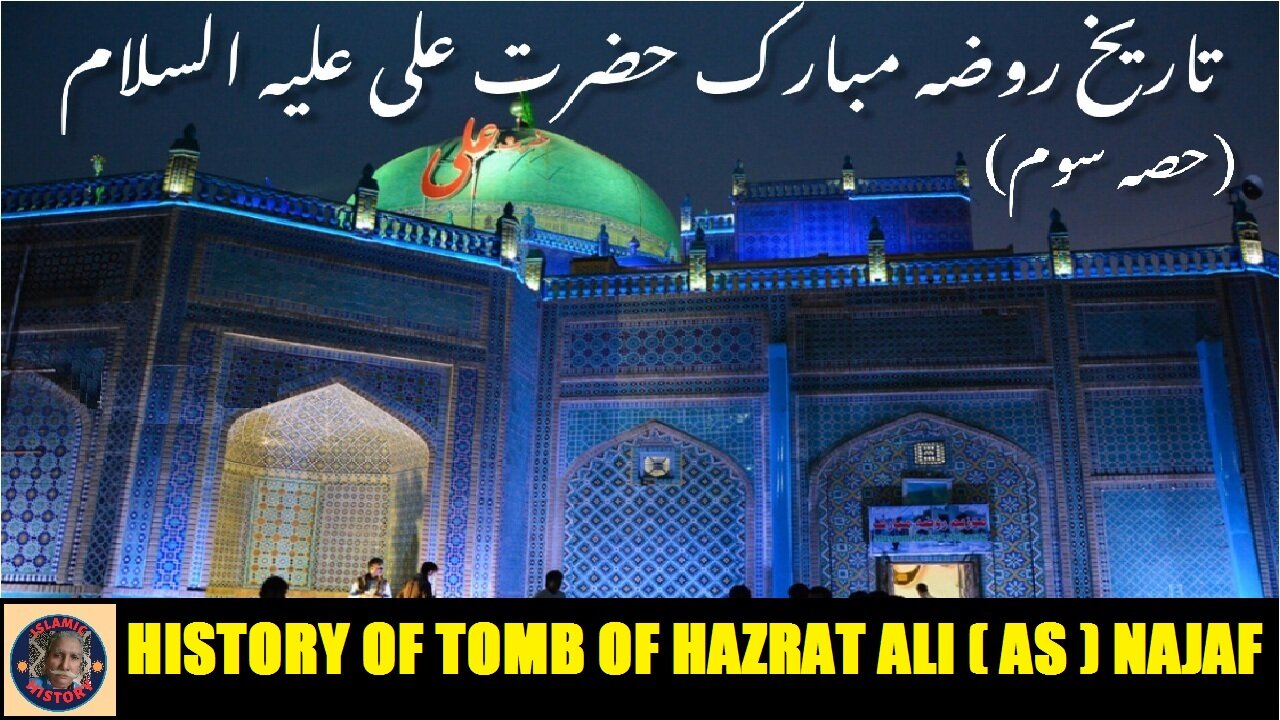Premium Only Content

Part-3 | The History of Shrine Hazrat Imam Ali (AS) روضہ مبارک حضرت امام علی علیہ السلام کی تاریخ
@islamichistory813 #IslamicPilgrimage #HazratAli #SacredSite
The History of Islamic Holiest site Shrine Hazrat Imam Ali (AS)
Part-3
Asslamoalaikum sisters brothers friends and elders, Today we are describing remaing history of most holiest place of Muslim Tomb of Hazrat Imam Ali (AS), Please be with us upto end of this video. as we are describing about holiest sites of Islam. Describing the historical background and religious importance of this sacred site, and learn about the revered figure of Hazrat Imam Ali (AS) in Islamic tradition.
Masjid Al-Ra's (lit. the Mosque of the 'Head') is located in the west of the courtyard. With regards to how the name of the mosque became as such, there are two opinions:[20]
The mosque is located opposite to where the head of Imam Ali (a) lies in his grave.
A hadith has been narrated from Imam Ja'far al-Sadiq (a) that says that the head of Imam al-Husayn (a) was actually buried in this area.
Masjid al-Khadra'
Masjid al-Khadra' (lit. the Green Mosque) is located in the eastern side of the courtyard. This mosque was where Ayatollah al-Khoei taught his lessons. In fact, recently the wall between this mosque and the grave of Ayatollah al-Khoei, was removed and replaced with a window made from stained glass.[21]
Husainiyya Sahnn Sharif is located in the northern section of the courtyard. It was built by Sayyid Muhsin Zayni. This building was constructed as a resting place for pilgrims visiting the shrine of Imam Ali (a) and also contains a place to perform Wudu. For many years, it lay abandoned and ruined. However, when Saddam Hussein was toppled, Ayatollah al-Sistani commissioned its renovation and reopening.[22]
Iwan al-Ulama' (lit. veranda of scholars) is located in the central-northern section of the main hall. The reason that the place has been named as such is due to the fact that several scholars have been buried here.[23]
In the upper floor of the courtyard, there are 52 rooms, each of which has a veranda facing the courtyard. These 52 rooms make up a seminary. Behind each room, there is a hallway that leads to a stairway (to exit the seminary). These rooms were used for classes and as a place to rest by students of the Islamic seminary. After the uprising of the Iraqi people in the month of Safar 1377/August-September 1957, the Baathist regime evicted the students of the seminary from these rooms with the intent of weakening and destroying the Shia seminary. From then on, these rooms have remained empty.[24]
The Maqam (stance of) Imam al-Sadiq (a) is a spot located near the door of Masjid al-Ra's. It has been narrated that this is where Imam al-Sadiq (a) would pray when he came to perform the Ziyarah (visitation) of Amir al-Muminin (a). This spot, approximately fifty years ago was covered by a white dome, spanning the area of approximately 100 square meters. However, currently, there are no remnants of this building and the spot is simply a part of the shrine.[25]
Mawdi' al-Isba'ayn (lit. the place of two fingers) is across the place where the face of the Imam (a) lies. It has been said that there was a tyrant ruler whose name was Murra b. Qays who was once speaking about his tribe and forefathers. He asked the elders of the tribe about those who had passed away from his family, and in response, they said that many of them had been killed in a battle. He further asked about who had killed them, and they responded by saying that most of them had been killed at the hands of Ali b. Abi Talib (a). So, he asked where Imam Ali (a) had been buried and was told that he was buried in Najaf. Murra then sent an army of 2,000 individuals to storm Najaf. After six days of defending their city, the people of Najaf were defeated and Marra entered the shrine and began to destroy it. As he was about to exhume the grave, two fingers came out of the Darih, and as though they were a sword, cut him in half. At that very moment, the two halves of his body became stone. These two stones were then kept near the road/pathway, after which the army took them and hid them.
Development
The shrine of Imam Ali b. Abi Talib (a) has been expanded and renovated considerably in more recent years. The western section of the haram in its developmental plans, has been named after the Lady Fatima al-Zahra (a). This courtyard includes much of the western section of the shrine complex up until the Maqam Imam al-Sajjad (a). It is being designed and built by Iranian architects. Upon completion of these developmental plans, the total area for the shrine complex will span 140,000 square meters.
Friends tomorow same time inshaAllah we are going to described the history of Islamic holiest site Hazrat Imam Hussain shrine in Karbala. Allah hafiz
===============================
-
 17:05
17:05
ISLAMIC HISTORY
4 days agoKhawla bint al-Azwar | The Veiled Warrior of Islam | خولہ بنت الازوار |اسلام کی باپردہ جنگجو
1 -
 LIVE
LIVE
vivafrei
1 hour agoAnother "Trans" Mass Shooter? Rampage Jackson Keeps Digging? Democrats are Just Awful AND MORE!
2,275 watching -
 1:34:24
1:34:24
Redacted News
2 hours agoLIVE: Minnesota School Shooter’s Shocking Motive Revealed – Plus Trump Targets Soros w AG Ken Paxton
101K69 -
 DVR
DVR
StoneMountain64
5 hours agoHUNTING FOR THE FIRST WIN BACK ON WARZONE
45.5K1 -
 1:09:06
1:09:06
The Officer Tatum
2 hours agoBREAKING: Shooter IDENTIFIED TR*NS , Cracker Barrel CAVES To Pressure + MORE | EP 162
23K33 -
 53:47
53:47
Matt Kohrs
3 hours agoLIVE! Nvidia Earnings Call || NVDA Stock Reaction
18K1 -

Tudor Dixon
1 hour agoKarol Markowicz on Freedom, Immigration, and Saving the American Dream | The Tudor Dixon Podcast
51 -
 2:03:25
2:03:25
The Quartering
5 hours agoFlag Burning, Free Speech, Church Attack & More With Andrew Wilson
187K285 -
 LIVE
LIVE
The Robert Scott Bell Show
19 hours agoDr. Peter McCullough, Vaccines: Mythology, Ideology, and Reality, Dr. Dan Sullivan, Chiropractic - The RSB Show 8-27-25
175 watching -
 1:21:03
1:21:03
Darkhorse Podcast
4 hours agoFreedom, Tyranny, and Childhood Lost: The 291st Evolutionary Lens w/ Bret Weinstein & Heather Heying
34.2K16